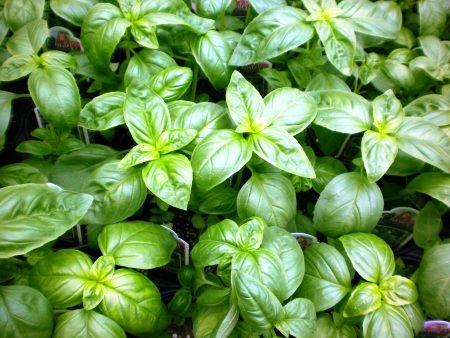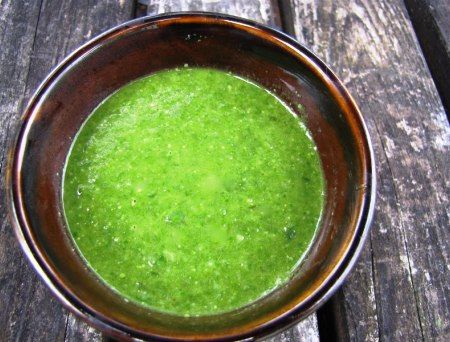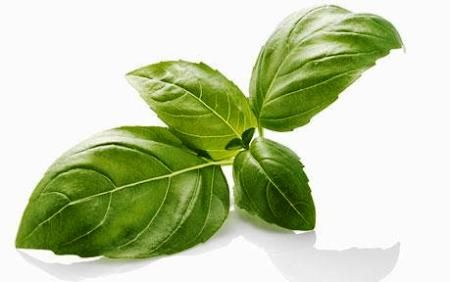Basics on Basil
Botanical name: Ocimum basilicum
If a kitchen has only a few herbs in its possession, basil will likely
be one of them. Its fragrant essence combines well with rosemary and thyme in
meat dishes, fish, vegetables, cheese, soup and eggs, and is one of the main
ingredients in pesto, along with pine nuts and parmesan cheese.
Although more than 60 varieties of basil have been identified, they all
fall into three main types: sweet, purple, and bush. Each offers a subtle
difference in taste; varieties such as lemon, anise, and cinnamon basil give
you an idea of how one might modify and enhance a recipe. It only takes a few
leaves to transform a simple dish - even a sandwich.
Basil plants are easy to maintain indoors and out. Snip off budding
heads whenever they appear and underneath the base of a leaf near the bottom on
spindly stems to keep your plant full, and a new branch will appear.
To dry basil leaves, warm your oven to 140 degrees while placing a
single layer of basil leaves on a baking sheet. Turn off the oven and pop in
your pan for 20 minutes (you don't want them to actually bake). Remove the pan,
cool the leaves, and store immediately in airtight bottles or zip-lock bags,
away from sunlight.
Health Benefits of Basil
Basil also is considered one of the healthiest herbs. It's best when
fresh, exuding a sweet, earthy aroma that indicates not only the promise of
pleasantly pungent flavor, but an impressive list of nutrients. Vitamin K,
essential for blood clotting, is one of them. Just two tablespoons of basil
provides 29 percent of the daily recommended value.
Basil also provides vitamin A, which contains beta-carotenes, powerful antioxidants that
protect the cells lining a number of numerous body structures, including the blood
vessels, from free radical damage. This helps prevent cholesterol in blood from oxidizing, helping to prevent
atherosclerosis, heart attacks, and stroke.
Other vitamins and minerals in basil include iron, calcium, manganese,
magnesium, vitamin C and potassium. Not surprisingly, basil also has
antibacterial properties and contains DNA-protecting flavonoids.
It's the flavonoids and volatile oils in basil that give it the most
health benefits, the former protecting on the cellular level, with
antibacterial properties related to its volatile oils. Among these are
estragole, linalool, cineole, eugenol, sabinene, myrcene, and limonene, all
capable of restricting the growth of numerous harmful bacteria, including
listeria, staphylococcus, E. coli, yersinia enterocolitica, and pseudomonas
aeruginosa.
Some antibiotic medications which have been found to be resistant to
some of these strains have been inhibited by basil extracts. One of those oils
- eugenol - can block the activity of the harmful enzyme cyclooxygenase (COX).
This same effect puts basil in the "anti-inflammatory" category
because it provides relief from related problems, such as rheumatoid arthritis.
Basil Nutrition Facts
Serving Size: 2 Tbsp. of chopped basil (5 grams)
- Calories: 1
- Vitamin K: 29%
- Vitamin A: 6%
- Vitamin C: 2%
- Calcium: 1%
- Iron: 1%
Studies Done on Basil
When scientists tested basil oil in diluted concentrations against
several common but serious multidrug-resistant bacteria, including some of
those listed above, it strongly reduced the negative effect of the bacteria.
Research data noted the encouraging results of the tests, especially in light
of the high level of resistance of the bacteria.1
Another study debated the traditional use of basil to treat several
respiratory diseases and the symptoms of tuberculosis, exploring the possible
use of basil against actual tuberculosis symptoms. Test results were
affirmative, with the conclusion that basil could be used to formulate new and
natural anti-tuberculosis treatments.2
Since basil extracts reduce sugars as well as free radicals in your
body, tests were conducted in relation to its effect on glycemic index, leading
researchers to conclude that basil extracts may have the potential to inhibit
diabetes.3
One impressive study showed that washing produce in a solution of basil
or thyme essential oil in just a 1% concentration diminished the number of
infectious Shigella bacteria, which can
produce intestine-damaging diarrhea. This result proves that ingesting
basil and thyme in as many ways as possible, especially fresh in salads and
their dressings, helps ensure the safety of the fresh produce you bring to your
table.
Basil Healthy Recipes: Spinach-Basil Green Minestrone Soup
Ingredients:
- 2 tablespoons extra virgin olive oil
- 4 ounces thick cut nitrate/nitrate-free prosciutto, chopped into 1-inch pieces
- 1 medium yellow onion, chopped
- 2 stalks of celery with leaves, chopped
- 2 cloves of garlic, finely minced
- 1 medium zucchini, diced
- 1 bay leaf
- 1 can cannellini beans (or other white bean)
- 1 can garbanzo beans (chickpeas)
- Sea salt and freshly ground pepper
- 8 cups chicken broth
- 1 cup mini penne pasta (or wheat-free pasta of your choice)
- ½ pound green beans, trimmed and cut into 1-inch pieces
- 10 ounces spinach, stems removed and coarsely chopped, or chard
- ½ cup grated Parmesan or Romano cheese (optional)
- ¼ cup chopped fresh basil (or parsley)
Procedure:
- Heat a large pot over medium high heat. Add oil and prosciutto. Sauté for 2 minutes, then add onions, celery, garlic, zucchini, and bay leaf. Season with salt and pepper to taste. Sauté for 5 minutes, stirring frequently.
- Add white beans, garbanzo beans, and chicken broth. Cover and bring to a boil.
- Add pasta and green beans and cook for 8 minutes, or until pasta is al dente (just tender). Stir in spinach to wilt, about 1 minute. Stir in cheese and serve in soup bowls. Top each serving with basil or parsley. Makes four servings.
(From Healthy Recipes for Your Nutritional Type by Dr. Mercola)
Basil Fun Facts
The ancient Greek word "basilikohn," meaning royal, is the
derivative of what we now call basil. It reflected an attitude of nobility and
a desire to extend hospitality, friendship, and honor whenever it was served.
Summary
Basil is arguably one of the favorites among herbs because it has so
many uses. Everything from soups to sandwiches can be made simply better with
the addition of its fresh, pungent leaves. It also has been found to contain
oils and flavonoids that protect the body from illness and infection. Very
small concentrations can kill harmful bacteria, but still be very beneficial,
even preventing atherosclerosis, heart attacks, and stroke.
Other sources:
http://voices.yahoo.com/the-7-healthiest-herbs-cooking-103570.html
http://www.whfoods.com/genpage.php?tname=foodspice&dbid=85
https://sites.google.com/site/spiritualfoodcsa/food-a-pedia/basil
http://www.pickyourown.org/DHbasilmint.htm
References:
1 http://www.ncbi.nlm.nih.gov/pubmed/12732427, Comparative studies on
the activity of basil--an essential oil from Ocimum basilicum L.--against
multidrug resistant clinical isolates of the genera Staphylococcus,
Enterococcus and Pseudomonas by using different test methods
2 http://www.ncbi.nlm.nih.gov/pubmed/22982011, Evaluation of the
antimycobacterium activity of the constituents from Ocimum basilicum against
Mycobacterium tuberculosis.
3 http://www.ncbi.nlm.nih.gov/pubmed/21636683, Hypoglycemic effect of
basil (Ocimum basilicum) aqueous extract is mediated through inhibition of
α-glucosidase and α-amylase activities: an in vitro study.Article source: http://foodfacts.mercola.com/basil.html

















































No comments:
Post a Comment